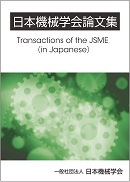Volume 85, Issue 871
Displaying 1-27 of 27 articles from this issue
- |<
- <
- 1
- >
- >|
Solid Mechanics and Materials Engineering
-
2019Volume 85Issue 871 Pages 18-00341
Published: 2019
Released on J-STAGE: March 25, 2019
Advance online publication: February 19, 2019Download PDF (1224K) -
2019Volume 85Issue 871 Pages 18-00376
Published: 2019
Released on J-STAGE: March 25, 2019
Advance online publication: February 18, 2019Download PDF (2883K) -
2019Volume 85Issue 871 Pages 18-00378
Published: 2019
Released on J-STAGE: March 25, 2019
Advance online publication: February 19, 2019Download PDF (2586K) -
2019Volume 85Issue 871 Pages 18-00397
Published: 2019
Released on J-STAGE: March 25, 2019
Advance online publication: February 08, 2019Download PDF (1743K) -
2019Volume 85Issue 871 Pages 18-00435
Published: 2019
Released on J-STAGE: March 25, 2019
Advance online publication: February 18, 2019Download PDF (1944K)
Fluids Engineering
-
2019Volume 85Issue 871 Pages 18-00476
Published: 2019
Released on J-STAGE: March 25, 2019
Advance online publication: February 14, 2019Download PDF (2000K)
Thermal, Engine and Power Engineering
-
2019Volume 85Issue 871 Pages 18-00278
Published: 2019
Released on J-STAGE: March 25, 2019
Advance online publication: February 14, 2019Download PDF (17044K) -
2019Volume 85Issue 871 Pages 18-00365
Published: 2019
Released on J-STAGE: March 25, 2019
Advance online publication: February 21, 2019Download PDF (2810K) -
2019Volume 85Issue 871 Pages 18-00366
Published: 2019
Released on J-STAGE: March 25, 2019
Advance online publication: February 21, 2019Download PDF (1968K) -
2019Volume 85Issue 871 Pages 18-00379
Published: 2019
Released on J-STAGE: March 25, 2019
Advance online publication: February 14, 2019Download PDF (7734K) -
2019Volume 85Issue 871 Pages 18-00395
Published: 2019
Released on J-STAGE: March 25, 2019
Advance online publication: February 21, 2019Download PDF (2470K) -
2019Volume 85Issue 871 Pages 18-00406
Published: 2019
Released on J-STAGE: March 25, 2019
Advance online publication: February 22, 2019Download PDF (2277K) -
2019Volume 85Issue 871 Pages 18-00477
Published: 2019
Released on J-STAGE: March 25, 2019
Advance online publication: February 28, 2019Download PDF (1666K)
Dynamics & Control, Robotics & Mechatronics
-
2019Volume 85Issue 871 Pages 18-00202
Published: 2019
Released on J-STAGE: March 25, 2019
Advance online publication: February 26, 2019Download PDF (4112K) -
2019Volume 85Issue 871 Pages 18-00260
Published: 2019
Released on J-STAGE: March 25, 2019
Advance online publication: February 26, 2019Download PDF (2725K) -
2019Volume 85Issue 871 Pages 18-00305
Published: 2019
Released on J-STAGE: March 25, 2019
Advance online publication: February 26, 2019Download PDF (1816K) -
2019Volume 85Issue 871 Pages 18-00336
Published: 2019
Released on J-STAGE: March 25, 2019
Advance online publication: March 04, 2019Download PDF (1728K)
Design, Machine Element & Tribology, Information & Intelligent Technology, Manufacturing, and Systems
-
2019Volume 85Issue 871 Pages 18-00098
Published: 2019
Released on J-STAGE: March 25, 2019
Advance online publication: March 08, 2019Download PDF (1887K) -
2019Volume 85Issue 871 Pages 18-00220
Published: 2019
Released on J-STAGE: March 25, 2019
Advance online publication: February 26, 2019Download PDF (2149K) -
2019Volume 85Issue 871 Pages 18-00258
Published: 2019
Released on J-STAGE: March 25, 2019
Advance online publication: March 08, 2019Download PDF (1494K) -
2019Volume 85Issue 871 Pages 18-00285
Published: 2019
Released on J-STAGE: March 25, 2019
Advance online publication: March 08, 2019Download PDF (2766K) -
2019Volume 85Issue 871 Pages 18-00385
Published: 2019
Released on J-STAGE: March 25, 2019
Advance online publication: February 15, 2019Download PDF (1654K) -
2019Volume 85Issue 871 Pages 18-00411
Published: 2019
Released on J-STAGE: March 25, 2019
Advance online publication: March 01, 2019Download PDF (1761K)
Bio, Medical, Sports and Human Engineering
-
2019Volume 85Issue 871 Pages 18-00356
Published: 2019
Released on J-STAGE: March 25, 2019
Advance online publication: February 19, 2019Download PDF (1413K)
Transportation and Logistics
-
2019Volume 85Issue 871 Pages 18-00116
Published: 2019
Released on J-STAGE: March 25, 2019
Advance online publication: February 08, 2019Download PDF (2515K) -
2019Volume 85Issue 871 Pages 18-00308
Published: 2019
Released on J-STAGE: March 25, 2019
Advance online publication: February 08, 2019Download PDF (1537K)
Space Engineering
-
2019Volume 85Issue 871 Pages 18-00311
Published: 2019
Released on J-STAGE: March 25, 2019
Advance online publication: February 22, 2019Download PDF (1803K)
- |<
- <
- 1
- >
- >|
